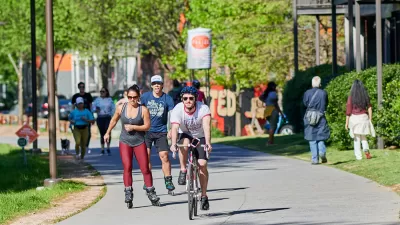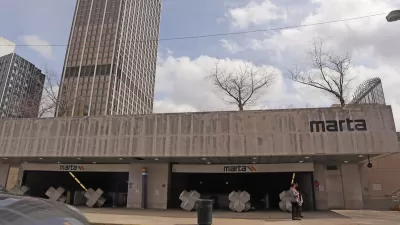The city once had an extensive streetcar system. Can it revive public transit once again?

An article in Atlanta Magazine by Rachel Garbus reminds readers that Atlanta once had a thriving public transportation system. “For the first half of the twentieth century, Atlanta’s public transportation system rivaled even that of bigger Northern cities like Baltimore and Pittsburgh. By 1928, the city’s streetcar system was so extensive, you could hop on in East Point and ride up to North Druid Hills, only changing trains once.”
The article includes historic photos of the city’s former electric streetcar system and explains how the system grew, then declined. At first, the (segregated) streetcars were operated by private companies. “Georgia officials mostly ignored public transit, pouring public dollars into highways instead. By the time MARTA took over transit as a public agency in 1972, the car had already won the fight for metro Atlanta.”
Now, traces of this history remain as opposition to public transit projects face opposition from “transit skeptics who think it’s a waste of taxpayer money to homeowners concerned about outsiders coming to their neighborhoods.”
Nicholas Bloom, author of The Great American Transit Disaster, says Atlanta may never reach world-class transit city status — “there’s been too much development to reverse engineer a public transit system” — “but he sees many opportunities to get people out of the cars into other modes of transportation.”
FULL STORY: Atlanta used to have extensive public transit, actually

Planetizen Federal Action Tracker
A weekly monitor of how Trump’s orders and actions are impacting planners and planning in America.

Restaurant Patios Were a Pandemic Win — Why Were They so Hard to Keep?
Social distancing requirements and changes in travel patterns prompted cities to pilot new uses for street and sidewalk space. Then it got complicated.

Map: Where Senate Republicans Want to Sell Your Public Lands
For public land advocates, the Senate Republicans’ proposal to sell millions of acres of public land in the West is “the biggest fight of their careers.”

Maui's Vacation Rental Debate Turns Ugly
Verbal attacks, misinformation campaigns and fistfights plague a high-stakes debate to convert thousands of vacation rentals into long-term housing.

San Francisco Suspends Traffic Calming Amidst Record Deaths
Citing “a challenging fiscal landscape,” the city will cease the program on the heels of 42 traffic deaths, including 24 pedestrians.

California Homeless Arrests, Citations Spike After Ruling
An investigation reveals that anti-homeless actions increased up to 500% after Grants Pass v. Johnson — even in cities claiming no policy change.
Urban Design for Planners 1: Software Tools
This six-course series explores essential urban design concepts using open source software and equips planners with the tools they need to participate fully in the urban design process.
Planning for Universal Design
Learn the tools for implementing Universal Design in planning regulations.
Heyer Gruel & Associates PA
JM Goldson LLC
Custer County Colorado
City of Camden Redevelopment Agency
City of Astoria
Transportation Research & Education Center (TREC) at Portland State University
Camden Redevelopment Agency
City of Claremont
Municipality of Princeton (NJ)





























